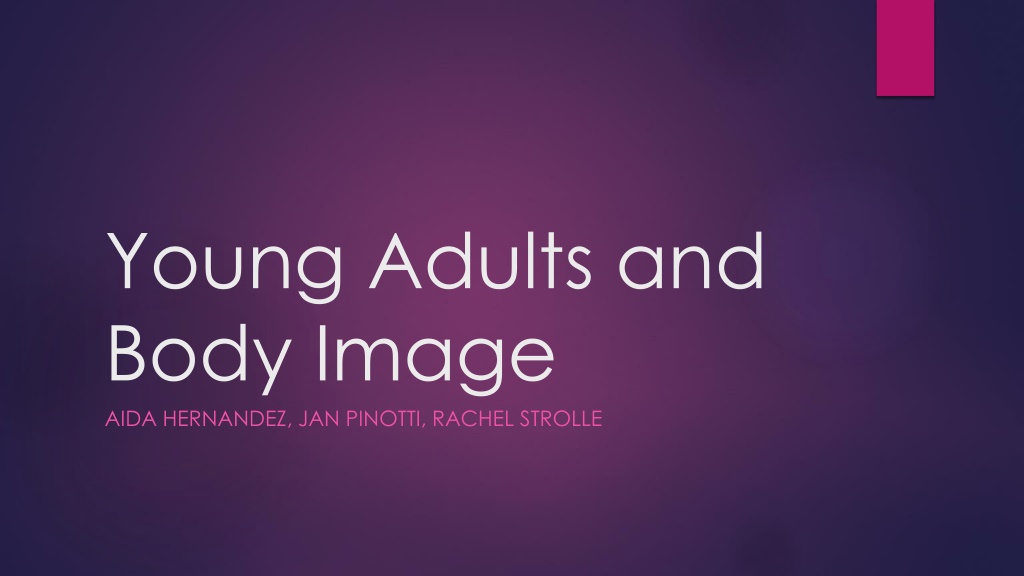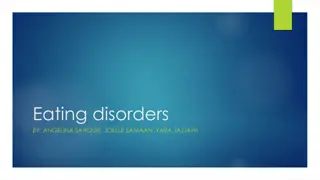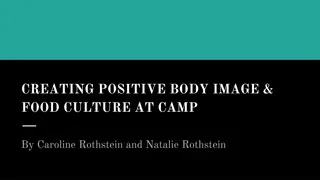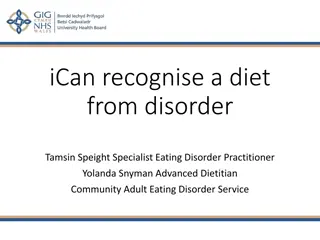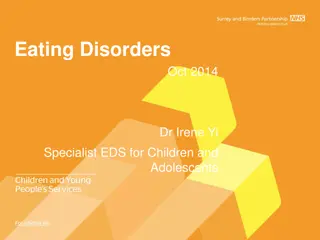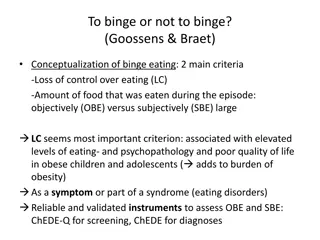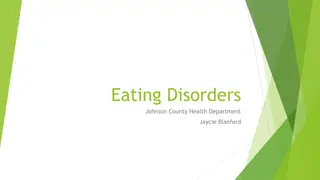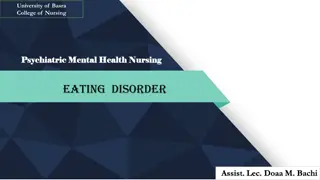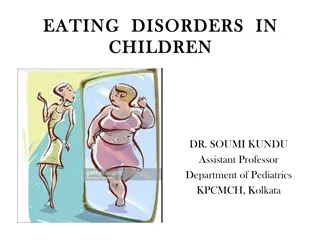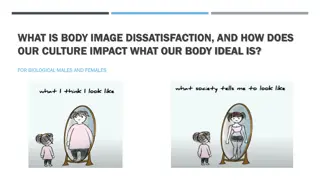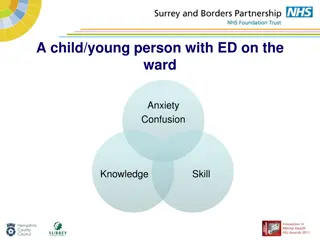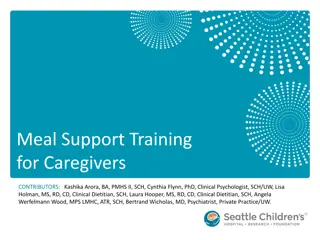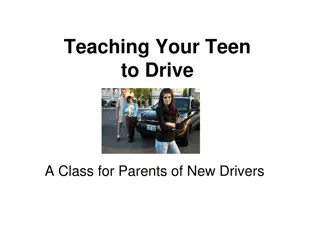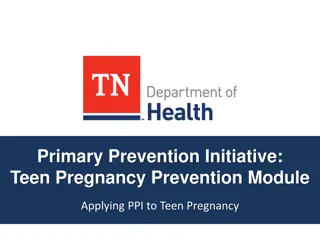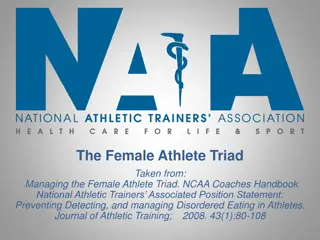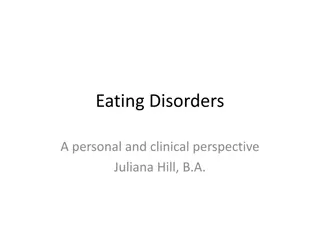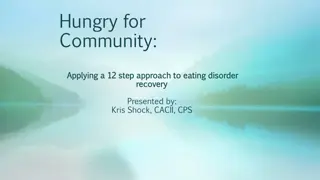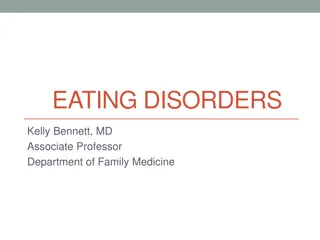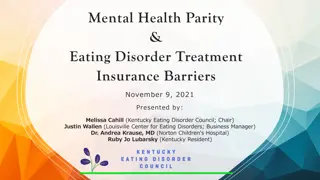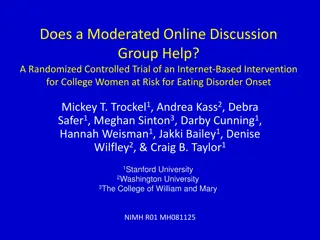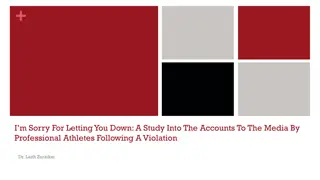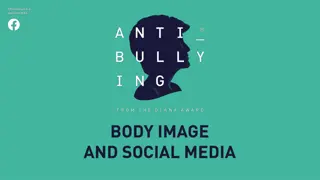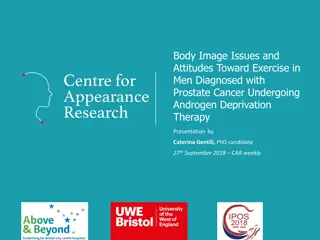Understanding Teen Body Image and Eating Disorders
Explore the complexities of body image among young adults, its positive and negative impacts, and common concerns such as weight, eating disorders, and cultural influences. Learn about the connection between negative body image and the development of eating disorders, and discover resources for support and information.
Download Presentation

Please find below an Image/Link to download the presentation.
The content on the website is provided AS IS for your information and personal use only. It may not be sold, licensed, or shared on other websites without obtaining consent from the author. Download presentation by click this link. If you encounter any issues during the download, it is possible that the publisher has removed the file from their server.
E N D
Presentation Transcript
Young Adults and Body Image AIDA HERNANDEZ, JAN PINOTTI, RACHEL STROLLE
What is Body Image? What you believe about your own appearance how you see yourself in the mirror or picture yourself in your mind How you feel about your body, including your height, shape, and weight How you sense and control your body as you move. How you feel in your body -Body image is influenced by many factors including; family environment, ability or disability, the attitudes of peers, the media and advertising, the fashion industry and cultural background. Resource: http: raisingchildren.net.au
Positive and Negative Body Image NEGATIVE POSITIVE A distorted perception of body shape A clear perception of body shape Belief that only others are attractive and that ones own body size/shape is a sign of failure Natural body shape is celebrated and appreciated Feelings of shame, self- consciousness, or anxiety about body Feelings of pride and acceptance about body Discomfort and awkwardness in ones body Comfort and confidence in ones body
Teen Body Image Concerns Weight Eating Disorders Skin Color Cultural differences/features Religious/Cultural Traditions Gender Identity Clothing/dress style Body Art Economic Status
Body Image and Size Photos from HarperCollins
Teen Body Image Concerns Weight Eating Disorders Skin Color Cultural differences/features Religious/Cultural Traditions Gender Identity Clothing/dress style Body Art Economic Status
Eating Disorders Eating disorders are complex conditions that arise from a variety of factors People with negative body image have a greater likelihood of developing an eating disorder More likely to suffer from feelings of depression, isolation, low self- esteem, and obsessions with weight loss 5 to 10 million females have battled eating disorders such as anorexia nervosa and bulimia National Eating Disorders Association. (n.d.) What is body image? Retrieved from: https://www.nationaleatingdisorders.org/what-body-image
Eating Disorders Photos from HarperCollins & Penguin
Teen Body Image Concerns Weight Eating Disorders Skin Color Cultural differences/features Religious/Cultural Traditions Gender Identity Clothing/dress style Body Art Economic Status
Skin Color Photos from Candlewick, Macmillan, & Penguin
Skin Color Photos from Harper Collins & Random House
Teen Body Image Concerns Weight Eating Disorders Skin Color Cultural differences/features Religious/Cultural Traditions Gender Identity Clothing/dress style Body Art Economic Status
Cultural Body Image Photos from Penguin, Cincos Puntos, & Scholastic
Cultural Body Image Photo from Harper Collins
Teen Body Image Concerns Weight Eating Disorders Skin Color Cultural differences/features Religious/Cultural Traditions Gender Identity Clothing/dress style Body Art Economic Status
Gender -The state of being female or male, or, our sense of self. -Gender is part of a broader, sociocultural context and refers to how society thinks we should act as girls and boys, women and men. Gender is complicated! -Complex is that our expectations of what it means to be male or female are often based on old ideas of what is masculine or feminine and these ideas change from culture to culture. Resource: Levkoff, Logan, and Jennifer Wider. Got Teens?: The Doctor Moms' Guide to Sexuality, Social Media and Other Adolescent Realities. Berkeley, CA: Seal, 2014. Print.
Truth is there is no one way to experience and express gender. Resource: Levkoff, Logan, and Jennifer Wider. Got Teens?: The Doctor Moms' Guide to Sexuality, Social Media and Other Adolescent Realities. Berkeley, CA: Seal, 2014. Print.
Gender Identity -Defined by our personal feelings about and/or inner sense of our own gender. -Studies show that gender identity usually develops during early childhood and can be shaped by parents, society, and a number of other biological factors. -For teens often their sense of self and gender are out of sync causing confusion and stigma in a turbulent time of their lives. Resource: Levkoff, Logan, and Jennifer Wider. Got Teens?: The Doctor Moms' Guide to Sexuality, Social Media and Other Adolescent Realities. Berkeley, CA: Seal, 2014. Print.
Transgender Teens Transgender individuals have a gender identity that differs from the sex they were assigned at birth Transgender teens face many personal and social issues in dealing with the perceptions and acceptance (or lack thereof) of both themselves and others Isolation can occur when the society around them is unable to deal with what they see as non-conformity Good Therapy.org. Working with Body Image Issues in Transgender People April 21, 2011- Contributed by Shirley Katz, PhD. CCC
Transgender Teens YA novels often reveal the issues experienced by transgender teens including: Poor body image Isolation Rejection Violence Medical Issues Depression Good Therapy.org. Working with Body Image Issues in Transgender People April 21, 2011- Contributed by Shirley Katz, PhD. CCC
Transgender Teens Photos from St. Martins Press, Random House, & Macmillan
Non-binary Teens Non-binary gender is any gender that isn t exclusively male or female. Non-binary individuals may feel a mix of female and male, somewhere in between, or something completely different
Genderfluid Teens Genderfluid falls under the non-binary umbrella Genderfluid individuals can feel exclusively male, exclusively female, multiple genders, or somewhere in between on any given day.
Genderfluid Teens Photos from Sourcebooks, Random House, and Scholastic
Body Image and the Media American teenagers spend: 31 hours a week watching TV 17 hours a week listening to music 3 hours a week watching movies 4 hours a week reading magazines 10 hours a week online That s 10 hours and 45 minutes of media consumption a day Siebel Newsom, J (2011). Documentary Miss Representation. United States
Body Image and the Media Over 80% of 10 year olds are afraid of being fat 53% of 13 year old American girls are unhappy with their bodies. This grows to 78% by the time girls reach 17 By middle school 40-70% of girls are dissatisfied with 2 or more parts of their body Around 30% of 10-14 year olds are actively dieting Over 50% of teen girls and 30% of teen boys use unhealthy weight control behaviors Adolescent girls who diet frequently are 12 times as likely to binge eat as girls who don t Gallivan, H.R. (n.d.) Teens, social media and body image. Park Nicollet Melrose Center. Retrieved from: http://www.macmh.org/wp- content/uploads/2014/05/18_Gallivan_Teens-social-media-body-image-presentation-H-Gallivan-Spring-2014.pdf
Body Image and the Media Of American elementary school girls who read magazines: 69% said that the pictures influence their concept of the ideal body shape 47% say the pictures make them want to lose weight. The average American Woman is 5 4 tall and weighs 144lbs, the average model is 5 10 and weighs 110lbs. The average female fashion model wears a size two or four, while the average American woman wears a size 12 to 14. Survey of the contents of Seventeen magazine found that the largest percentage of pages are devoted to articles about appearance. TV commercials, programming and movies almost exclusively feature thin, healthy looking people. Women s magazines have about 10 times the Content related to dieting and weight loss than men s magazines Gallivan, H.R. (n.d.) Teens, social media and body image. Park Nicollet Melrose Center. Retrieved from: http://www.macmh.org/wp-content/uploads/2014/05/18_Gallivan_Teens-social- media-body-image-presentation-H-Gallivan-Spring-2014.pdf Mirror, Mirror: Eating disorders. The media and body image. Retrieved from: http://www.mirror-mirror.org/the-media-and-body-image.htm Teen Futures Media Network (n.d.) Body image & nutrition: Fast facts. Retrieved from: http://depts.washington.edu/thmedia/view.cgi?page=fastfacts§ion=bodyimage
Body Image and the Media The appearance of females is commented on: 58 % in movies 28% in television shows 26% in commercials The appearance of mens' and boys' is talked about on: 24& in movies 10% in television shows 7% in commercials Teen Futures Media Network (n.d.) Body image & nutrition: Fast facts. Retrieved from: http://depts.washington.edu/thmedia/view.cgi?page=fastfacts§ion=bodyimage
Body Image and the Media 37% articles in leading teen girl magazines focus on appearance 50% of advertisements used an appeal to beauty to sell their products. Black-oriented television shows may serve a protective function; Hispanic and Black girls and women who watch more Black- oriented television have higher body satisfaction. Pressure from mass media to be muscular also appears to be related to body dissatisfaction among men. Young men seem to be more negatively affected by the media images than adolescent boys are. National Eating Disorders Association. (n.d.) Media, body image, and eating disorders Retrieved from: https://www.nationaleatingdisorders.org/media- body-image-and-eating-disorders
Body Image and the Media Research: in Fiji after TV was introduced found that scores on eating pathology doubled in three years and influenced their opinion on ideal body shape. in Australia found that seeing thin models on TV and in magazines made girls feel that they weren t good enough, pretty enough, or thin enough. The researchers also concluded that in many instances, the media influences had been reinforced by peers and family. Project EAT found that girls who read articles on dieting or weight loss were 6 times more likely to engage in unhealthy weight control behaviors. Boys were 4 times more likely. Gallivan, H.R. (n.d.) Teens, social media and body image. Park Nicollet Melrose Center. Retrieved from: http://www.macmh.org/wp- content/uploads/2014/05/18_Gallivan_Teens-social-media-body-image-presentation-H-Gallivan-Spring-2014.pdf
Advertising Advertising, particularly for fashion and cosmetics, has a powerful effect on how we see ourselves and how we think we should look. MEDIASMARTS Media Smarts: Canada s Centre for Digital and Media Literacy. Body image: Advertising and Magazines. Retrieved from: http://mediasmarts.ca/body- image/body-image-advertising-and-magazines
Photoshop As a result, heavily retouched photos of men as well as women have become nearly universal: a single issue of Vogue was found to contain 144 manipulated images, including the cover. MEDIASMARTS Media Smarts: Canada s Centre for Digital and Media Literacy. Body image: Photo manipulation. Retrieved from: http://mediasmarts.ca/body- image/body-image-photo-manipulation
Body Image and the Media Girls get the message from very early on that what s most important is how they look, that their value, their worth, depends on that. And boys get the message that this is what s important about girls. Miss Representation Siebel Newsom, J (2011). Documentary Miss Representation. United States
Body Image and the Media http://www.shoppersshop.com/pics/victoria_justice_teen_vogue_september_2010.jpg, http://cdn01.cdn.justjaredjr.com/wp-content/uploads/headlines/2011/01/lucy-hale-teen-vogue- feb-2011.jpg , https://encrypted-tbn1.gstatic.com/images?q=tbn:ANd9GcQXbuG0Xb69rmsOAHKTD-72qqYfw7Ja7L6_o4JmXZooYxzMIFm8nw , http://sev.h- cdn.co/assets/cm/15/09/54ee70cf3963f_-_1978-43629680-lgn.jpg , https://s-media-cache-ak0.pinimg.com/originals/7b/3c/ff/7b3cff26073fa4f68c7556cea9749629.jpg https://s-media-cache-ak0.pinimg.com/236x/1f/f9/cc/1ff9cc58258f341563f65700ac3aa836.jpg
The ideal image of beauty is more extreme and impossible than ever before. JEAN KILBOURNE Siebel Newsom, J (2011). Documentary Miss Representation. United States
Body Image and the Media Pic Kim: http://images.complex.com/complex/image/upload/c_limit,w_680/fl_lossy,pg_1,q_auto/laqfnuomvvtf4qhtutyy.jpg Pic JLaw: http://providr-com.s3.amazonaws.com/all-images/celeb-images-photoshop2.jpg Pic PenCruz: http://www.fahv.com/wp-content/uploads/2013/02/penelope-cruz-photoshop-before-and-after.jpg Pic: Bieber: http://static2.businessinsider.com/image/54afe28b6bb3f7e620141ef4/it-looks-as-if-calvin-klein-photoshopped- justin-bieber-to-give-him-a-bigger-bulge.jpg Pic Model: http://cdn.ebaumsworld.com/mediaFiles/picture/718392/84719308.jpg
Body Image and the Media Visual platforms like Facebook, Instagram and Snapchat deliver the tools that allow teens to earn approval for their appearance and compare themselves to others. Rachel Simmons The rise of the wellness industry through social media have created a fitness celebrities, also known as, fitspiration . Some of the time these regimens of eating and exercising disguised as health , clean eating , and wellness come from pro-anorexia or thinspiration sites. Siebel Newsom, J (2011). Documentary Miss Representation. United States
Body Image and the Media Thinspiration 4,530,000 results Pro-ana 22,200,000 results Simmons, R. (2016, August 19). How social media is a toxic mirror. Time.com Retrieved from: http://time.com/4459153/social-media-body-image/ Pic 1: http://www.myproana.com/uploads/gallery/album_8294/sml_gallery_87204_8294_27273.jpg Pic 2: https://s-media-cache-ak0.pinimg.com/236x/1a/5a/66/1a5a66675cd916e84cb5279e50e06f84.jpg Pic 3: http://www.myproana.com/uploads/gallery/album_13840/gallery_119950_13840_13740.jpg
Body Image and the Media Body positive 22,700,000 results Be You Campaign 10,900,000 results Pic 1: http://4.bp.blogspot.com/-XljkXM1QYds/UYaFVQAac6I/AAAAAAAADbs/yWvG8i- F4Ow/s1600/we_r_all_wonderwomen_sm.jpg Pic 2: https://ih0.redbubble.net/image.149102981.2385/flat,1000x1000,075,f.u6.jpg Pic 3: http://i.huffpost.com/gen/2252188/thumbs/o-DEAR-KATE-570.jpg?6
Effects of Negative Body Image anxiety, depression, low self-esteem, shame, and trouble concentrating take risks with their sexual health cut themselves off from being with other people socially stop doing healthy activities that require them to show their bodies, such as exercising, having sex, going to the doctor, or swimming suffer from serious mental health problems, such as anorexia, bulimia, over-exercising, or overeating. Planned Parenthood. (n.d.) Body image at a glance: How can a negative body image affect my health and well-being? Retrieved from: https://www.plannedparenthood.org/learn/body-image
Body Image Shifts After Trauma Photos from St. Martins, Simon & Schuster, & Penguin
Resources Eating Disorder Hope https://www.eatingdisorderhope.com/information/body-image Just Say YES https://www.justsayyes.org/ National Eating Disorders Association https://www.nationaleatingdisorders.org/ Teen Futures Media Networkhttp://depts.washington.edu/thmedia/
Reference Gallivan, H.R. (n.d.) Teens, social media and body image. Park Nicollet Melrose Center. Retrieved from: http://www.macmh.org/wp-content/uploads/2014/05/18_Gallivan_Teens-social-media-body-image-presentation-H- Gallivan-Spring-2014.pdf Levkoff, Logan, and Jennifer Wider. Got Teens?: The Doctor Moms' Guide to Sexuality, Social Media and Other Adolescent Realities. Berkeley, CA: Seal, 2014. Print. Media Smarts: Canada s Centre for Digital and Media Literacy. Body image: Advertising and Magazines. Retrieved from: http://mediasmarts.ca/body-image/body-image-advertising-and-magazines Media Smarts: Canada s Centre for Digital and Media Literacy. Body image: Photo manipulation. Retrieved from: http://mediasmarts.ca/body-image/body-image-photo-manipulation Mirror, Mirror: Eating disorders. The media and body image. Retrieved from: http://www.mirror-mirror.org/the-media-and- body-image.htm National Eating Disorders Association. (n.d.) What is body image? Retrieved from: https://www.nationaleatingdisorders.org/what-body-image Planned Parenthood. (n.d.) Body image at a glance: How can a negative body image affect my health and well-being? Retrieved from: https://www.plannedparenthood.org/learn/body-image Siebel Newsom, J (2011). Miss Representation. United States Simmons, R. (2016, August 19). How social media is a toxic mirror. Time.com Retrieved from: http://time.com/4459153/social- media-body-image/ Teen Futures Media Network (n.d.) Body image & nutrition: Fast facts. Retrieved from: http://depts.washington.edu/thmedia/view.cgi?page=fastfacts§ion=bodyimage
